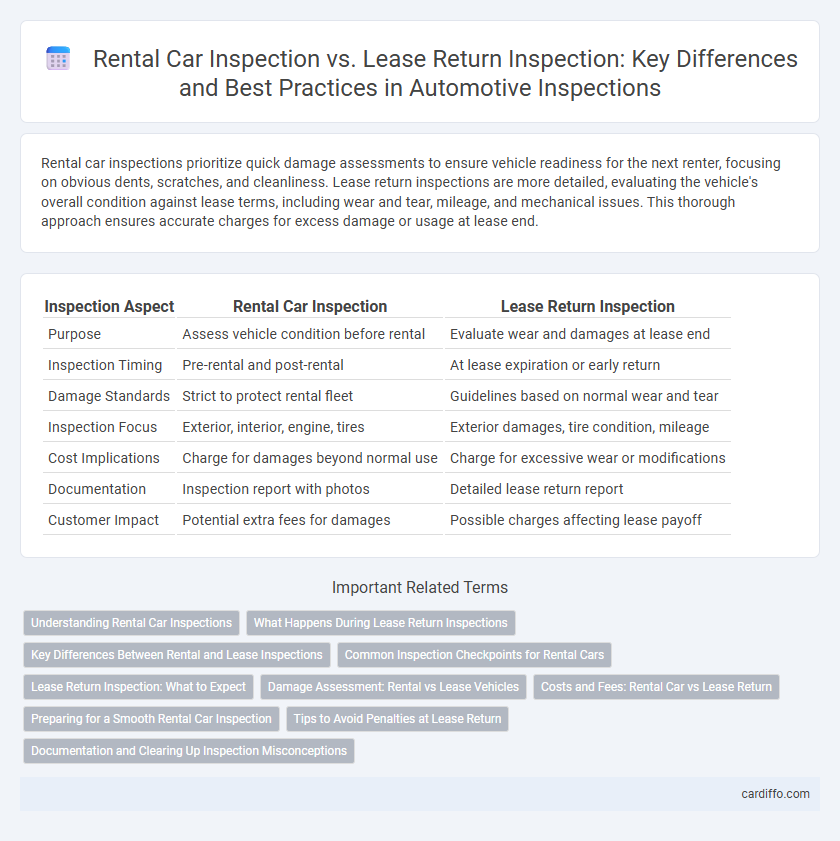Rental car inspections prioritize quick damage assessments to ensure vehicle readiness for the next renter, focusing on obvious dents, scratches, and cleanliness. Lease return inspections are more detailed, evaluating the vehicle's overall condition against lease terms, including wear and tear, mileage, and mechanical issues. This thorough approach ensures accurate charges for excess damage or usage at lease end.
Table of Comparison
| Inspection Aspect | Rental Car Inspection | Lease Return Inspection |
|---|---|---|
| Purpose | Assess vehicle condition before rental | Evaluate wear and damages at lease end |
| Inspection Timing | Pre-rental and post-rental | At lease expiration or early return |
| Damage Standards | Strict to protect rental fleet | Guidelines based on normal wear and tear |
| Inspection Focus | Exterior, interior, engine, tires | Exterior damages, tire condition, mileage |
| Cost Implications | Charge for damages beyond normal use | Charge for excessive wear or modifications |
| Documentation | Inspection report with photos | Detailed lease return report |
| Customer Impact | Potential extra fees for damages | Possible charges affecting lease payoff |
Understanding Rental Car Inspections
Rental car inspections focus on assessing vehicle condition before and after each rental period to document any damages or wear, ensuring accurate billing and maintaining fleet quality. Inspectors use standardized checklists to evaluate tires, brakes, exterior body, and interior cleanliness, capturing any discrepancies promptly. This process differs from lease return inspections by emphasizing short-term vehicle usage and quick turnover readiness rather than long-term depreciation assessment.
What Happens During Lease Return Inspections
During lease return inspections, the vehicle undergoes a thorough assessment to identify any excessive wear and tear, damages, or mileage overage beyond the lease agreement limits. Inspectors check the car's exterior and interior condition, including dents, scratches, tire wear, and upholstery damage, comparing it against predefined standards. Any identified issues can result in additional charges or repair requirements before the lease is officially closed.
Key Differences Between Rental and Lease Inspections
Rental car inspections primarily focus on immediate vehicle condition and cleanliness between short-term users, emphasizing damages, fuel levels, and mileage to ensure readiness for the next renter. Lease return inspections involve a detailed evaluation of wear and tear against the lease agreement's standards, assessing any excessive damage or mileage overages that could incur additional charges. The key difference lies in rental inspections being frequent and quick to maintain vehicle turnover, while lease inspections are thorough, occurring at lease end to determine potential financial liabilities.
Common Inspection Checkpoints for Rental Cars
Common inspection checkpoints for rental cars include assessing the vehicle's exterior for dents, scratches, and tire condition, as well as examining the interior for cleanliness, damage to upholstery, and functionality of dashboard instruments. Inspectors also verify fluid levels, check for any mechanical issues, and ensure all safety features like lights and brakes are operational. These checkpoints are critical to maintaining vehicle quality and safety standards throughout rental periods.
Lease Return Inspection: What to Expect
Lease return inspections focus primarily on assessing vehicle condition against lease agreement standards, identifying excess wear, damage, and mileage overages. Inspectors evaluate tire tread depth, interior cleanliness, dents, scratches, and mechanical functionality to determine potential charges. Understanding these criteria helps lessees avoid unexpected fees and negotiate appropriate repairs before returning the vehicle.
Damage Assessment: Rental vs Lease Vehicles
Rental car inspections prioritize identifying any new damage incurred during the rental period to ensure accurate billing for repair costs, often emphasizing minor scratches, dents, and interior wear. Lease return inspections focus on assessing damage relative to normal wear and tear standards outlined in the lease agreement, with particular attention to excess wear that may result in additional charges. Both inspections require detailed damage assessment protocols but differ in criteria and consequences tied to the vehicle's ownership and usage terms.
Costs and Fees: Rental Car vs Lease Return
Rental car inspections often include immediate charges for damages, cleaning, and fuel discrepancies, leading to unpredictable and higher costs for short-term users. Lease return inspections typically involve detailed evaluations of wear-and-tear based on lease agreement standards, with potential fees applied only if the vehicle exceeds agreed limits or sustains excessive damage. Understanding these inspection fee structures helps consumers anticipate expenses and avoid surprise charges during rental returns or lease terminations.
Preparing for a Smooth Rental Car Inspection
Preparing for a smooth rental car inspection requires thoroughly checking the vehicle for any visible damage, ensuring the fuel level matches the rental agreement, and cleaning the interior and exterior to meet company standards. Documenting the car's condition with photos before returning can help avoid disputes over damages or fees. Understanding specific rental policies and returning the car on time minimizes potential inspection issues and fees.
Tips to Avoid Penalties at Lease Return
Perform a thorough pre-return inspection of your leased vehicle to identify and repair minor damages such as scratches, dents, and worn tires, which can reduce costly penalties. Document the car's condition with photos and maintain detailed records of all maintenance services performed during the lease period. Pay close attention to the lease agreement's wear-and-tear guidelines to ensure compliance with manufacturer standards and avoid unexpected charges at lease return.
Documentation and Clearing Up Inspection Misconceptions
Rental car inspection documentation typically includes condition checklists and damage reports to ensure transparency during short-term rentals, while lease return inspections require detailed records of wear and tear aligned with lease agreements to avoid end-of-term penalties. Clearing up misconceptions involves clarifying that normal wear is expected in lease returns and does not necessarily incur charges, unlike undisclosed damages in rental inspections which can lead to extra fees. Transparent documentation and clear communication between customers and providers are essential for smooth inspection processes and dispute resolution.
Rental car inspection vs lease return inspection Infographic

 cardiffo.com
cardiffo.com